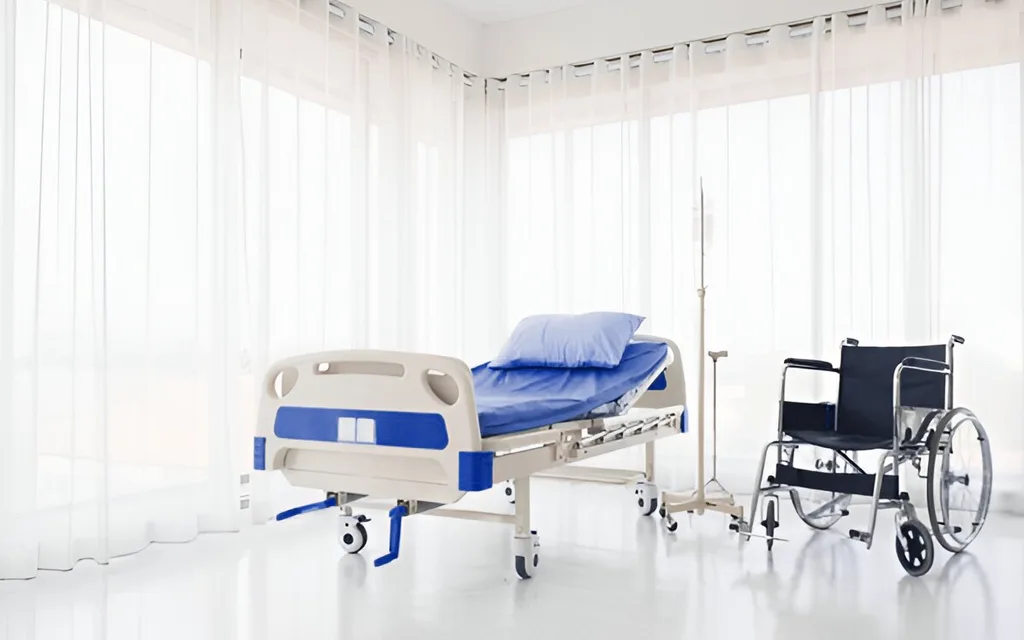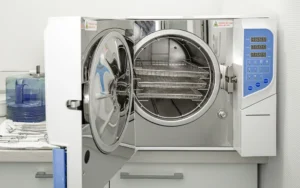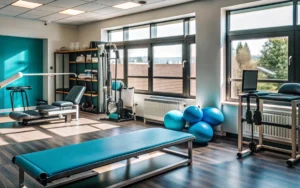If you’re looking for hospital furniture for your hospital or clinic in Dubai, you’re making a significant investment.
So, you need to consider several factors before spending your money. Our hospital equipment experts are here to guide you.
Let’s hear what they have to say.
[ez-toc]
10 Must-Have Tips for Buying Hospital Furniture
Before buying hospital furniture in Dubai, there are several factors you should consider, such as patient care, staff efficiency, functionality, durability, safety and hygiene standards, budget, and much more.
1. Understand Your Specific Needs
Understanding your hospital’s size, specialty, and patient demographics is the first important step in choosing the right furniture. It’s not just about picking out beds and chairs; it’s about making sure the furniture fits the needs of your hospital’s daily operations.
The size and specialty of your hospital will guide what kind of furniture you need. For example, a small local clinic won’t need the same heavy-duty equipment as a large city hospital.
A surgical center, where patients undergo operations, needs specialized tables, adjustable lighting, and recovery beds. On the other hand, a mental health facility might focus on creating a calm environment with comfortable, soft furniture to help patients feel at ease.
Understanding the people who visit your hospital is also crucial. If your hospital serves mostly older adults, you’ll want furniture that’s easy for them to use—like chairs with armrests for support or beds that can be lowered for easier access.
For pediatric hospitals, you’ll need fun, colorful furniture that’s sized for kids, along with playful designs to make them feel more comfortable. A children’s hospital might also have areas for play to help keep kids entertained and distracted.
Before making any decisions, it’s important to spend time in your hospital, talking to staff and patients. By understanding the specific needs of your hospital, you can choose furniture that makes everyone’s experience better, from patients to healthcare workers.
2. Functionality:
Good furniture helps both patients and staff by making things easier and more comfortable. For patients, furniture should be supportive and easy to use. Beds should adjust easily to provide comfort, chairs should be the right height to make sitting and standing easy, and tables should be positioned for comfort and convenience. All of this helps patients feel better and recover faster.
For staff, furniture should make their work easier, too. Carts should roll smoothly so nurses can move them easily, exam tables should be simple to clean and adjust, and storage should be organized to keep everything within reach. This saves time and reduces strain on staff, allowing them to focus on patient care.
Hospitals are busy places, and furniture faces a lot of wear and tear. Whether it’s constant use, frequent cleaning, or just being moved around, hospital furniture needs to be tough and long-lasting.
High-traffic areas like waiting rooms, hallways, and emergency rooms need furniture that can withstand heavy use.
Beds are adjusted multiple times a day, carts are moved around constantly, and chairs are sat in by many people. All of this requires furniture made of durable materials that can handle harsh cleaning agents.
3. Patient Comfort:
Comfort and safety are essential when choosing hospital furniture, and ergonomic designs play a big role in both. Imagine trying to rest in a bed that’s uncomfortable or sitting in a chair that causes back pain. That’s not going to help anyone recover. That’s why furniture designed with the human body in mind is so important.
When patients feel comfortable, they’re happier, and happier patients lead to better experiences and higher satisfaction with their care. Comfort also helps reduce stress and anxiety, which is important for healing. A comfortable environment can make a big difference in how patients feel throughout their stay.
When patients feel comfortable, they’re happier, and happier patients lead to better experiences and higher satisfaction with their care. Comfort also helps reduce stress and anxiety, which is important for healing. A comfortable environment can make a big difference in how patients feel throughout their stay.
Hospitals need to be safe places, and furniture plays a big part in that. Here are some key safety features to consider:
- Furniture like chairs and tables should be stable to prevent accidents, especially for elderly patients.
- Furniture should be strong enough to support patients of all sizes.
- Furniture surfaces need to be easy to clean and disinfect to stop the spread of germs. Materials like antimicrobial fabrics and non-porous surfaces help prevent infections.
- Beds and bathroom furniture should have rails or grab bars to help patients move safely.
- Carts and beds should have wheels that lock in place to prevent them from rolling unexpectedly.
Hospitals are places where germs can easily spread, so it’s important to use furniture that’s easy to clean and disinfect. Furniture made from materials that resist bacteria and viruses helps protect patients and staff from infections.
It’s also important that everyone, no matter their abilities, feels comfortable and safe. Accessible furniture is designed for patients with different needs. This could include furniture with easy-to-reach controls, higher beds for patients with mobility issues, or chairs that are easy to get in and out of.
4. Accessibility
Hospitals need to make sure all patients, including those with disabilities or mobility challenges, feel welcome and comfortable. This means the furniture must be designed to meet their needs.
- If a table is too high or too low, it can be hard for some patients to use. Height-adjustable tables solve this by allowing the table to be raised or lowered to the right height for each person, whether they’re sitting in a chair or using a wheelchair.
- Furniture should be easy to access for patients in wheelchairs. This includes making sure there’s enough space under tables, using chairs with armrests that can be moved aside, and keeping pathways clear.
- For patients with limited mobility, chairs should provide good support. These chairs should reduce pressure and make it easier for patients to get in and out. Look for chairs with good back support and armrests that help patients stand up.
- Furniture should also leave room for assistive devices like walkers, canes, and scooters.
5. Incorporate the Latest Technologies
Hospitals are becoming smarter with their furniture, thanks to the power of technology. It’s not just about comfy chairs anymore—furniture is now designed to make things better for both patients and staff.
These are no longer just basic hospital beds. Now, they can be controlled with a remote or even a voice command. These beds can adjust to different positions to help with breathing, circulation, and comfort. Some even have sensors that track a patient’s movements and vital signs.
Smart Chairs can monitor a patient’s weight, posture, and heart rate. They can also give gentle massages to help with pain and relaxation.
Some beds and tables come with built-in touchscreens, allowing patients to access entertainment, get information about their care, or even have video calls with loved ones.
These carts can move supplies and medications automatically around the hospital. This saves staff time and reduces the chance of errors.
The trend of using smart furniture in hospitals is growing rapidly and it brings many benefits.
Smart furniture helps patients feel more comfortable, reduces pain, and improves their overall experience. It can also monitor their health and send early warnings if something goes wrong.
Automated furniture saves staff time and reduces their workload, which allows them to focus more on patient care. It also helps hospitals manage resources more effectively.
Many smart furniture items collect important data that can be used to improve patient care and hospital operations. This information helps doctors and nurses make more informed decisions.
Examples:
- A bed that automatically adjusts to prevent bedsores.
- A chair that alerts a nurse if a patient’s heart rate drops.
- A medication cart that automatically records when medications are dispensed.
In short, technology is making hospital furniture smarter, more efficient, and more helpful, which is changing how hospitals provide care and improving the experience for everyone.
6. Infection-resistant furniture for hospitals and clinics
Hospitals are places where germs can spread quickly, so it’s important to have furniture that’s easy to clean and disinfect. Keeping furniture clean helps prevent the spread of infections, especially for patients who are already sick or have weak immune systems. Regular cleaning and disinfection are key to maintaining a safe and healthy environment.
The right furniture design makes cleaning and disinfecting much easier.
Furniture with smooth, non-porous surfaces is much easier to clean than furniture with rough or porous surfaces. Materials like stainless steel, solid plastics, and laminate are perfect because they don’t trap dirt or germs. They can be wiped down easily.
Furniture with fewer seams and crevices is also easier to clean. Seams and crevices can trap dirt and germs, making them hard to get rid of. Look for furniture with welded or molded designs, which are easier to clean and maintain.
Since hospital furniture gets cleaned often, it needs to be made from materials that can handle harsh cleaning agents. Stainless steel, high-pressure laminate, and antimicrobial fabrics are great choices because they resist damage and are easy to disinfect.
Furniture that has removable cushions, covers, or trays makes cleaning even easier. These parts can be taken off, cleaned separately, and put back, ensuring every surface gets disinfected properly.
Furniture should be designed so that every surface is easy to clean. This includes hard-to-reach spots under beds, behind chairs, and around tables. Keeping these areas accessible ensures that no germs are left behind.
7. Plan for Space Optimization
Maximizing space in small clinics or large hospitals is essential for creating an efficient and comfortable environment. Whether you’re working with limited space or need to make the most of a large area, smart furniture choices can make a big difference.
Modular furniture is one of the best ways to optimize space. It can be rearranged to fit different needs and layouts. You can combine or separate pieces as necessary, allowing flexibility in how you use the space. This type of furniture adapts easily to changes in your clinic or hospital’s setup.
Foldable furniture is another excellent option for small spaces. Items like chairs, tables, and even beds that fold up can be stored away when not in use. This helps save space and keeps the area neat and tidy, offering more room when you need it.
Multi-functional furniture serves more than one purpose, which is perfect for limited spaces. For example, a bed that can also function as a chair, or a storage unit that doubles as a workstation. This reduces clutter and ensures that every piece of furniture serves a valuable function.
Vertical storage is another space-saving solution, especially for smaller areas. Tall cabinets or shelving units can store supplies without taking up much floor space, helping to keep the area organized and clear.
To maintain a comfortable and functional space, it’s important to keep pathways clear. Choose furniture that doesn’t block walkways or overcrowd rooms. Easy-to-move furniture helps maintain clear, safe areas for staff and patients.
For example, modular exam tables can be arranged in various ways to fit the room’s layout, while foldable stools and chairs can be tucked away when not needed. Multi-functional carts with built-in storage can also be used for patient care or transporting equipment.
By incorporating space-saving furniture, you can create a more organized and efficient space, making both small and large medical environments more effective and comfortable.
8. Cost and Quality
When it comes to buying hospital furniture, balancing cost and quality is crucial. You want to stick to your budget but still ensure the furniture is durable and comfortable. Creating a realistic budget starts with understanding your needs. Prioritize what is essential for patient care and staff efficiency. Set a clear budget for each category, whether it’s beds, chairs, or storage units.
One way to manage costs without sacrificing quality is by purchasing in bulk. Buying in larger quantities can help you negotiate better prices with suppliers. It’s an effective way to save money, especially for items like chairs or storage that are used throughout the facility.
Leasing furniture is another great option. This allows you to avoid upfront costs and spread the expense over time. Leasing is especially helpful for items that might need to be replaced or updated regularly, like examination tables or medical carts.
Refurbished furniture is also a smart cost-saving strategy. You can find high-quality used furniture that has been restored to like-new condition. Refurbished items often come at a fraction of the price of new furniture, making them a budget-friendly option for non-essential pieces.
By carefully planning your budget and exploring cost-saving options like bulk purchasing, leasing, or refurbished furniture, you can get high-quality hospital furniture without overspending. It’s all about finding the right balance between cost and quality to meet your hospital’s needs.
9. Explore Customization Options
Customizable furniture is a great way to meet the unique needs of your hospital or clinic. It allows you to tailor the furniture to fit specific requirements, whether it’s for branding, specialized storage, or patient-specific designs. Customization ensures that every piece of furniture serves its purpose and enhances the overall experience.
For instance, adjustable-height tables are a popular choice for creating a comfortable environment for both patients and staff. These tables can be easily modified to different heights, making them ideal for various tasks, from medical exams to office work. This feature can reduce strain on staff and provide better comfort for patients.
Custom color schemes can help match the furniture to your hospital’s branding, creating a consistent look throughout the facility. Whether you want to incorporate your logo or use soothing colors to help patients feel more relaxed, custom colors can add a personal touch and make the environment more welcoming.
Another example is furniture that integrates technology. Some hospital beds or chairs can have built-in screens for entertainment or patient monitoring. This type of integration makes it easier to manage patient care and enhances the overall comfort and experience.
Customization allows you to create a space that works perfectly for your needs. Whether it’s specialized storage for medical supplies or furniture designed to support specific patient requirements, customization gives you the flexibility to design a facility that’s both functional and aligned with your goals.
10. Partner with Reputable Suppliers
Partnering with reputable suppliers is crucial when buying hospital furniture. You want to make sure that you are getting quality products and reliable service. Start by checking the supplier’s certifications.
These ensure that the furniture meets industry standards for safety and durability. It’s also important to ask about warranties. A good warranty will protect you in case anything goes wrong with the furniture after purchase.
Customer reviews can give you insight into the supplier’s reputation. Look for feedback from other hospitals or clinics. Positive reviews show that the supplier delivers quality products and reliable service.
Delivery timelines are another important factor. Make sure the supplier can deliver the furniture within the time frame you need. Delays can disrupt your operations, so a supplier with reliable delivery is essential.
After-sales support is just as important. A good supplier will provide assistance after the furniture has been delivered. Whether it’s for maintenance, replacement parts, or addressing any issues, responsive after-sales support helps keep things running smoothly.
When evaluating suppliers, make sure they have a solid reputation, offer warranties, and provide excellent customer service. By partnering with a trusted supplier, you ensure that your hospital gets high-quality furniture that lasts and meets your needs.
Conclusion
Selecting the right hospital furniture is an essential step for hospital owners and purchasers. The 10 tips we’ve covered are crucial for making informed decisions that will benefit your facility in the long run. From understanding your hospital’s needs to ensuring the furniture is both functional and durable, these tips help you create a space that promotes comfort, safety, and efficiency.
Taking a strategic approach to furniture selection is key to long-term success. When you choose the right furniture, it not only improves patient care but also boosts staff efficiency. High-quality, well-designed furniture contributes to a positive environment, which enhances the overall reputation of your facility.
The right furniture will make a difference in how patients feel and how staff perform. It’s an investment that pays off by creating a better experience for everyone involved.
If you’re facing challenges in purchasing hospital furniture, it’s important to partner with reputable suppliers. Learn more about choosing the best suppliers by visiting Partner with Reputable Hospital Furniture Supplier.
For tips on maintaining and cleaning hospital furniture to ensure its longevity, check out our blog on How to maintain and clean hospital furniture for longevity












